If you are looking for a professional-type grill with high output without spending $6,000 to $8,000, the Lynx Sedona and the Weber Summit Series are two very good options.
However, they are extremely different in their grilling, searing, roasting, and smoking capabilities.
What's better for you depends on how you use your grill.
This article will break down the $4,059 Lynx Sedona with Infrared Pro Sear and the $2,949 six-burner Weber Summit feature for feature.
In the end, you will know which grill may be right for you.
Let's get started.
Lynx Sedona vs. Weber Summit BBQ Grills
First, let's look at both lines starting with the Lynx Sedona.
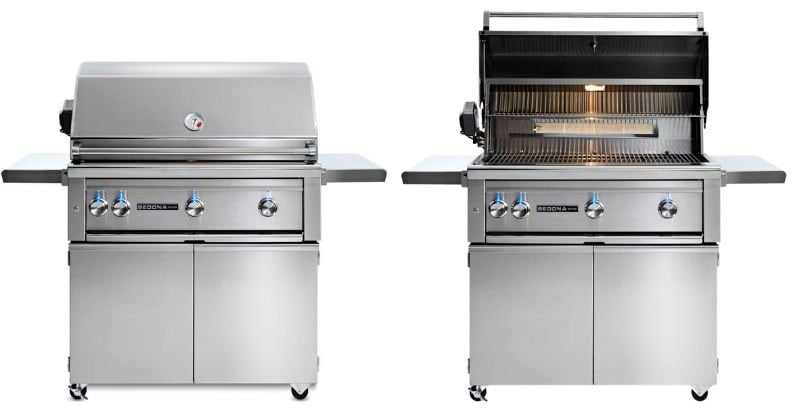
Sedona is available in three different sizes at 42, 36, and 30 inches.
The difference between the 42 and the 36-inch grills is the cooking area in square inches. The 36-inch Lynx Sedona has a total of 891 square inches compared to 1,049 for the 42-inch size. Both have 69,000 BTU of output.
The 30-inch Lynx Sedona has 733 square inches total of cooking area with 46,000 BTU.
You can buy the Sedona four ways in three different sizes.
- Pro Sear Infrared Burner With Rotisserie
- Pro Sear Burner Without Rotisserie
- All Gas Burners With Rotisserie
- All Gas Burners Without Rotisserie
Sedona is available in freestanding or built-in.
Features:
- Free delivery and assembly on all grills over $499
- Two Stainless Steel burners and one ProSear Burner (total 69,000 BTUs)
- Time tested spark ignition system with battery backup
- Control illumination with blue LEDs
- Temperature gauge
- Fluid rotation handle
- Lynx Hood Assist Kit
- Stainless steel grilling grates
- 891 sq. in cooking surface (618primary, 273 secondary)
- Dual halogen grill surface lights
- Heat stabilizing design
- Dedicated rotisserie backburner with rotisserie motor, spit rods, and forks
- Heavy-duty welded construction eliminates gaps where grease and moisture can collect
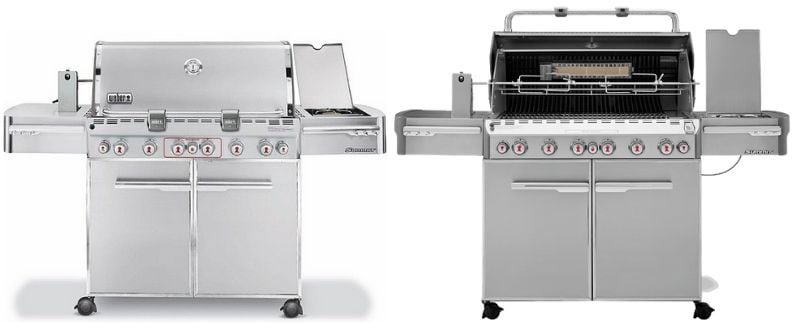
Weber Summit is available in two sizes, either four burners or six burners.
The E series has enamel grates and hood, whereas the S series is stainless with more durable stainless steel grates (shown above).
Both have standard features including the rotisserie, 10,000 BTU rotisserie burner, 12,000 BTU side burners, 6,800 BTU smoker box, and a 10,600 BTU sear zone.
The Weber Summit has built-in grills but is purchased more in freestanding with the cart attached (shown above).
Features:
- BTU Output for Main Burners: 60,000 BTU
- Infrared Rotisserie
- Sear Station Burner: Btu-per-hour Input: 10,600
- Stainless Steel Smoker Box And Smoker Burner: Btu-per-hour Input: 6,800
- Side Burner: Btu-per-hour: 12,000
- Rear-mounted, Infrared Rotisserie Burner: Btu-per-hour Input: 10,600
- Primary Cooking Area (Square Inches): 624
- Warming Rack Area (Square Inches): 145
- Total Cooking Area (Square Inches): 769
- Stainless Steel Burners: 6
- Fuel Type: Liquid Propane (20 Lb. Tank Sold Separately)
- Side Tables: 2
- Lighted Control Knobs: 6
- Handle Lights: 2
Lynx Sedona vs. Weber Summit BBQ Grills: What are there Differences?
| |
Lynx Sedona L600PSFR |
Weber Summit Series S-670 Grill 7370001 |
| Gas Type |
Propane or Natural Gas |
Propane or Natural Gas ($30 more) |
| Configuration |
on Cart |
on Cart |
| Number of Main Burners |
3 |
6 |
| Main Grilling Area (sq in.) |
618 sq in. |
624 sq in. |
| Infrared Sear Zone |
Optional |
N/A |
| Burner Type |
Stainless U Burner |
Tube |
| Main Burner BTUs |
23000 |
10000 |
| Cooking Grates |
Stainless Rod |
Stainless Rod |
| Smoker Box |
No |
Yes |
| Ignition |
Electronic Ignition with Battery Backup |
Flame Thrower (Snap-Jet) |
| Hood Assist |
Yes |
No |
| Interior Lights |
One |
No |
| Control Panel Lighting |
Yes (Blue LED) |
Lighted Knob |
| Rotisserie Motor |
Yes |
Yes |
| Rotisserie Burner BTUs |
14000 |
10600 |
| Heat Distribution System |
Ceramic Briquettes |
Flavorizer Bars |
| Warranty |
Lifetime - Burners, Cooking Grates |
10 Years - All Parts |
| Side Burner |
No |
12000 |
| Sear Burner |
23,000 infrared) |
Not Really* |
| Folding Side Shelves |
Yes |
No |
| Made in the U.S. |
YES |
YES (Some Components) |
| Price |
$4,059 |
$2,949 |
Fit and Finish
The Sedona is more polished with its spring-loaded lid. It's easier to open than the Summit.
As for their steel composition, the Sedona is more solid at 201 versus type 304 for the Summit.
Ignition
Lynx is electronic with a battery operated back up to light quickly.
Incredibly, Weber did not include the Summit in their last round of GS4 improvements. They use an older but still reliable snap jet, flame thrower ignition.
Heat Distribution
They both have different heat distribution systems.
Lynx has ceramic briquettes to reduce flare-ups and increase heat, whereas the Summit uses one row of stainless flavorizer bars.
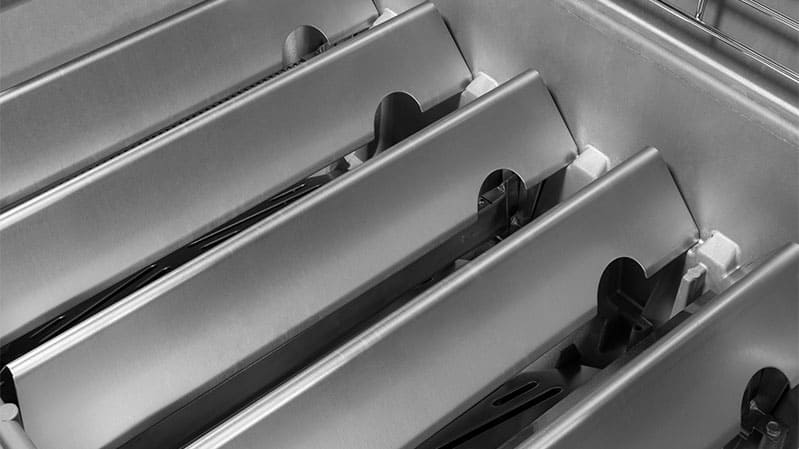 Weber Flavorizer Bars
Weber Flavorizer Bars
The ceramic briquettes are a bit better, especially for cleaning, because all you have to do is flip them over to clean themselves versus manually cleaning the bars on the Summit.
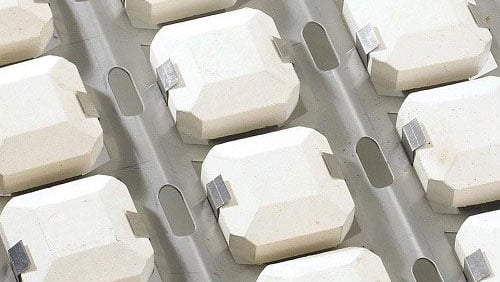 Lynx Sedona Grill Ceramic Briquettes
Lynx Sedona Grill Ceramic Briquettes
Once again, the Summit has only one row of flavors versus two for their improved Genesis II and Spirit II series.
Construction
In terms of the overall construction, Lynx has a one-touch hood, so it is much easier to open. They both have lighted knobs, but Lynx has blue LEDs and has a light in the grill itself.
Size
The usable cooking space is nearly identical at 618 square inches for the Lynx and 624 for the Summit.
Burners and BTU Output
At first glance, Weber seems like a more powerful grill.
The Lynx Sedona L600PSFR has 69,000 (46,000 in gas plus the 23,000 BTU infrared) total BTU.
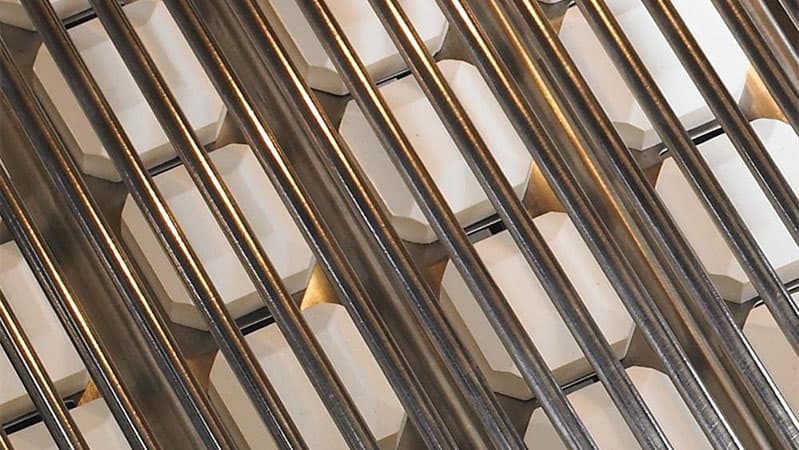 Lynx Sedona Burners
Lynx Sedona Burners
The Summit has 60,000 BTU and a 10,600 BTU sear station plus a 6,800 BTU smoker to infuse your food with additional flavor.
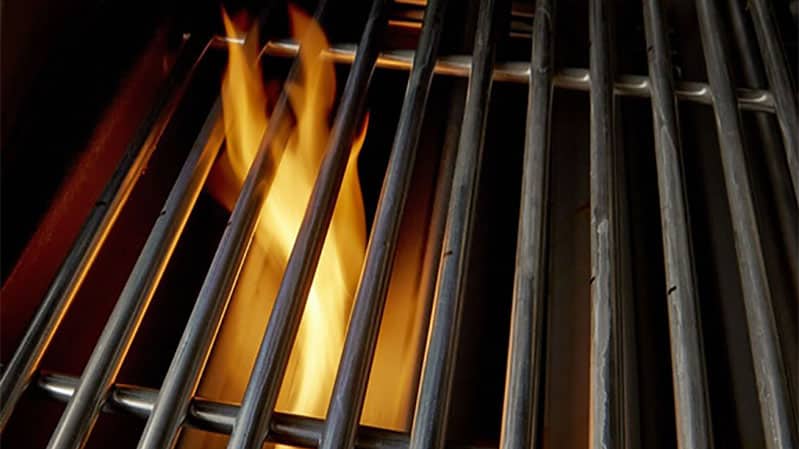 Weber Summit S-670 Burners
Weber Summit S-670 Burners
It even has a 12,000 BTU side burner if you want to cook without having to run back and forth to your kitchen.
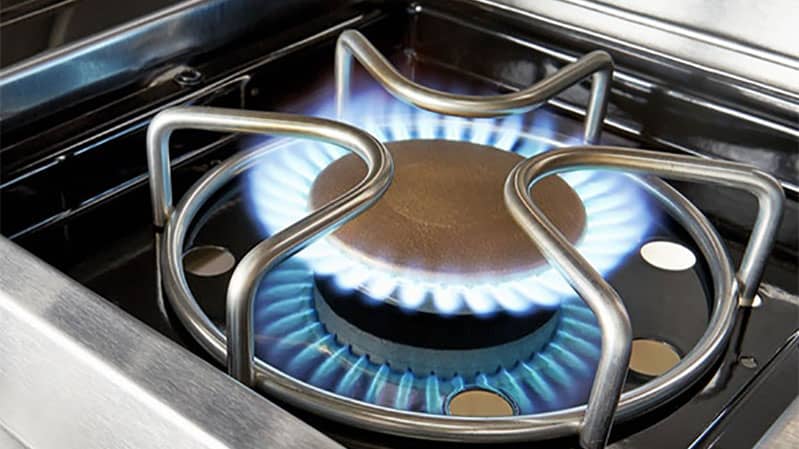 Weber Summit S-670 Series Side Burner
Weber Summit S-670 Series Side Burner
Lynx does not have a side burner.
However, comparing total BTU will now give you an idea of what you will grill. Weber uses six 10,000 BTU elements versus 23,000 for the Lynx, so the Lynx will be hotter to grill faster and more evenly.
Sear
It's important to understand the searing capabilities of each. The Summit will call there a sear station, but it is just another row of 10,600 burners in reality.
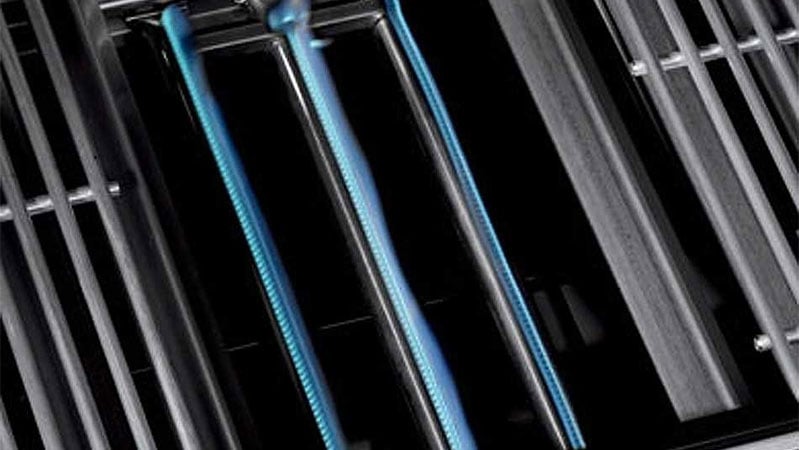 Weber Summit Sear Station
Weber Summit Sear Station
The Lynx is an infrared 23,000 BTU sear, so it is much hotter.
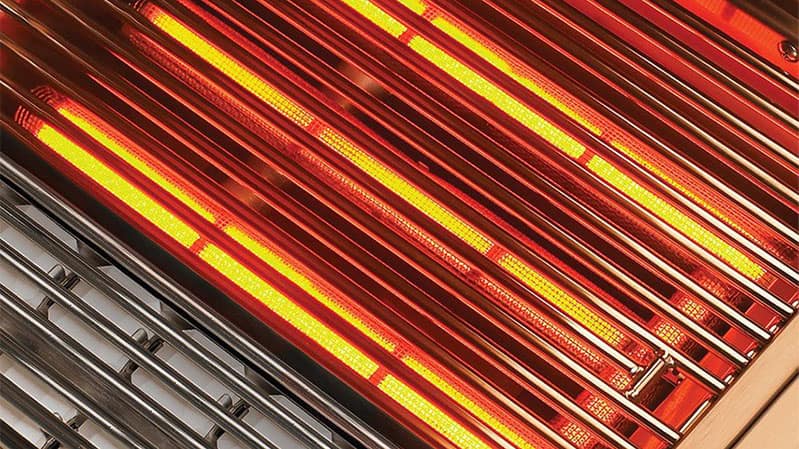 Lynx Sedona Grill Infrared Burner
Lynx Sedona Grill Infrared Burner
Infrared is also a more intense, directed heat, whereas gas diffuses a flame similar to a gas burner on your stove.
Unlike most infrared burners, the Lynx is variable to sear fruits and veggies at lower temperatures.
Rotisserie
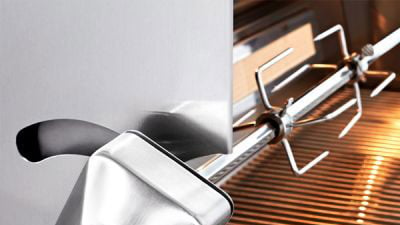 Lynx Sedona Rotisserie
Lynx Sedona Rotisserie
In terms of rotisseries, they both have infrared on the back of the grill for even cooking. However, Lynx's rotisserie burner is rated at 14,000 vs. 10,600 for the Weber.

Which Grill Should You Buy?
Both the Lynx Sedona and the Weber Summit are about the same size.
The Weber Summit has a smoking capability and a side burner, so you don't have to go back and forth to your kitchen.
The Sedona is a hotter grill with a more powerful 23,000 BTU burner and a real 23,000 sear that sears quickly. It also is a bit easier to light and a lot easier to clean.
Ultimately, your decision comes down to having Weber's smoker box and side burner at a lower price versus Sedona's hotter burners, better sear, and overall better construction.
Additional Resources
Get the Yale BBQ Grill Buying Guide with features, specs, and tips to all the brands. Over 900,000 people have already found answers in a Yale Guide.

Related Articles:
Why Should You Trust Us?
It seems that every appliance review has nothing but glowing comments about almost every product, yet you read customer reviews and they are almost universally bad.
We are here to fill in the disconnect. We'll give you the best features, and the drawbacks as well, including reliability based on over 37,000 calls performed by our service team just last year. Our goal is to give you ALL the information so you know what's right for you.
Please consider subscribing or adding to the conversation in the comments below. We appreciate you stopping by.

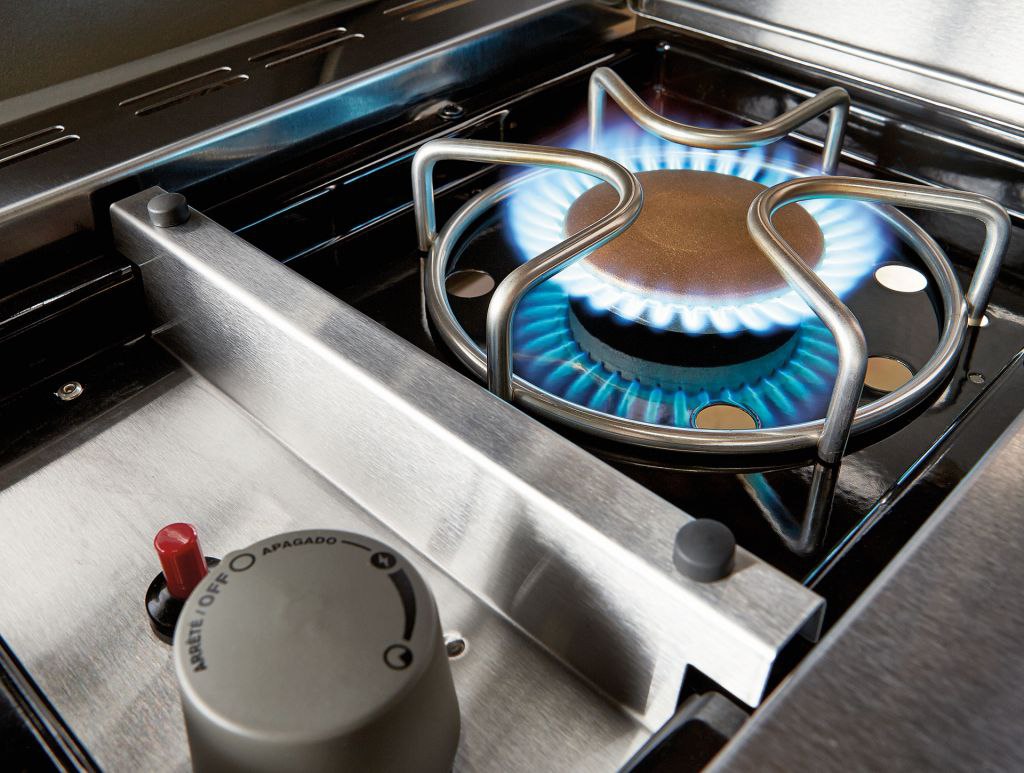



 Lynx Sedona Grill Ceramic Briquettes
Lynx Sedona Grill Ceramic Briquettes
 Weber Summit S-670 Burners
Weber Summit S-670 Burners Weber Summit S-670 Series Side Burner
Weber Summit S-670 Series Side Burner Weber Summit Sear Station
Weber Summit Sear Station Lynx Sedona Grill Infrared Burner
Lynx Sedona Grill Infrared Burner

